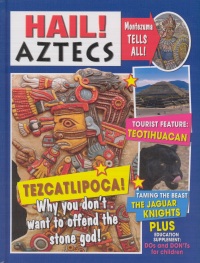| ________________
CM . . . . Volume XVII Number 20. . . .January 28th, 2010. 
 |
Ancient Chinese. (Hail!).
Paul Challen.
St. Catharines, ON: Crabtree, 2011.
32 pp., pbk. & hc., $9.95 (pbk.), $20.76 (RLB.).
ISBN 978-0-7787-6628-5 (pbk.), ISBN 978-0-7787-6621-6 (RLB.).
Subject Heading:
China-Civilization-To 221 B.C.-Juvenile literature.
China-Civilization-221 B.C.-960 A.D.-Juvenile literature.
Grades 4-6 / Ages 9-11.
Review by Gail Hamilton.
*** / 4
|
| |
 |
Ancient Egyptians. (Hail!).
Jen Green.
St. Catharines, ON: Crabtree, 2011.
32 pp., pbk. & hc., $9.95 (pbk.), $20.76 (RLB.).
ISBN 978-0-7787-6629-2 (pbk.), ISBN 978-0-7787-6622-3 (RLB.).
Subject Heading:
Egypt-Civilization-To 332 B.C.-Juvenile literature.
Egypt-Social life and customs-To 332 B.C.-Juvenile literature.
Grades 4-6 / Ages 9-11.
Review by Gail Hamilton.
*** / 4
|
| |
 |
Ancient Greeks. (Hail!).
Jen Green.
St. Catharines, ON: Crabtree, 2011.
32 pp., pbk. & hc., $9.95 (pbk.), $20.76 (RLB.).
ISBN 978-0-7787-6630-8 (pbk.), ISBN 978-0-7787-6623-0 (RLB.).
Subject Heading:
Greeks-Civilization-To 146 B.C.-Juvenile literature.
Egypt-Social life and customs-Juvenile literature.
Grades 4-6 / Ages 9-11.
Review by Gail Hamilton.
*** / 4
|
| |
 |
Ancient Romans. (Hail!).
Philip Steele.
St. Catharines, ON: Crabtree, 2011.
32 pp., pbk. & hc., $9.95 (pbk.), $20.76 (RLB.).
ISBN 978-0-7787-6631-5 (pbk.), ISBN 978-0-7787-6624-7 (RLB.).
Subject Heading:
Rome-Civilization-Juvenile literature.
Rome-Social life and customs-Juvenile literature.
Grades 4-6 / Ages 9-11.
Review by Gail Hamilton.
*** / 4
|
| |
 |
Aztecs. (Hail!).
Jen Green.
St. Catharines, ON: Crabtree, 2011.
32 pp., pbk. & hc., $9.95 (pbk.), $20.76 (RLB.).
ISBN 978-0-7787-6632-2 (pbk.), ISBN 978-0-7787-6625-4 (RLB.).
Subject Heading:
Aztecs-Juvenile literature.
Aztecs-Social life and customs-Juvenile literature.
Grades 4-6 / Ages 9-11.
Review by Gail Hamilton.
*** / 4
|
| |
 |
Tudors. (Hail!).
Philip Steele.
St. Catharines, ON: Crabtree, 2011.
32 pp., pbk. & hc., $9.95 (pbk.), $20.76 (RLB.).
ISBN 978-0-7787-6633-9 (pbk.), ISBN 978-0-7787-6626-1 (RLB.).
Subject Heading:
Tudor, House of-Juvenile literature.
Great Britain-Social life and customs-16th century-Juvenile literature.
Great Britain-History-Tudors, 1485-1603-Juvenile literature.
Grades 4-6 / Ages 9-11.
Review by Gail Hamilton.
*** / 4
|
| |
| |
|

excerpt:
It is hard working in the fields all day. You need comfort for all that hoeing and harvesting. And it is important to stay cool in the summer and warm in winter. That is why the well-dressed rural guy or gal sports a loose-fitting, shirt-like garment made of wool or hemp. You can also cover your head against the elements. Complete the look with shoes made of straw.
If you are a nobleman or woman, or high-ranking official, you have your status in society to maintain. And what is the good of having lots of extra cash to spend if you cannot show off your wealth? Silk robes and gold, silver, or jade jewelry on your wrists or around your neck will give you that extra fashionable look. (From Hail! Ancient Chinese.)
Terracotta Army: You could be a model! Cleopatra: The truth about Mark Antony! Celeb Profile: Alexander. These are just a few of the attention grabbers on the covers of some of the titles in this six-volume series. Designed to look like an entertainment magazine, each book showcases a specific culture and time in history, but with a unique twist. Modern day terminology and magazine "departments," such as celebrity profiles, travel, entertainment, letters to an advice columnist, real estate, fashion, food and classified ads engage readers and provide snippets of information that might encourage them to delve more thoroughly into the subject at a later date. Some of the information requires a bit of prior knowledge in order for readers to fully understand the humour behind it. Each title is comprised of 13 chapters as well as a table of contents, a glossary, an index, a time line and a list of web sites and books for further study. From the descriptions provided, it is likely that many of the web sites will garner some interest- ancient Chinese recipes to try, games, activities and quizzes about ancient Egypt, and audio of Aztec musical instruments, to name a few. The layout of the books is busy and in keeping with the theme of the entertainment magazine. Colours are bright and eye-catching, and there are plenty of photographs and some diagrams and maps.
Ancient Chinese begins with the Xia Dynasty in 2070 BCE (CE and BCE are used throughout the series). This title focuses on the history of China, the building of the Great Wall, the importance of rice in the Chinese diet, and the role played by astrology in the culture, one example being the Chinese zodiac. There is also information about fashion, entertainment and a fun advice column entitled, "Ask Confucius." Perhaps the most interesting topic in the book is the contributions made by the Chinese to the world- gunpowder, fireworks, paper, silk, umbrellas, the compass, calligraphy, acupuncture and shadow puppets- but the most fascinating is the seismograph. This earthquake predictor, created in 132 CE, consists of a vase-like object with eight dragons around the rim and eight toads, mouths wide open, below. In each of the dragons' mouths is a ball. If a ball drops into the mouth of a toad, it means an earthquake is coming from the direction of the toad that swallows the ball.
Three thousand years of Egypt"s ancient history are covered in Ancient Egyptians. Though the usual topics are featured, they are presented in novel ways. For example, there is a TV guide for Pharaoh TV with program descriptions providing facts about the Old, Middle and New kingdoms; a careers guide explains several of the jobs that were popular in ancient Egypt- vizier, potter, weaver, soldier, scribe and bricklayer; and a section entitled "Makeover" provides step-by-step instructions for mummifying a body and a mock homepage offers "grave goods to meet all your needs in the afterlife" at Afterlife.com. As well, there are ads for clothing, a travel supplement of places to visit, and a section about King Tut that includes a profile of the boy king and "Tut's Blog." An "online catalog" will take care of all ancient Egyptians' shopping needs, with ads for exotic pets, a scribe for hire, and tomb cleaners, to name a few. Readers will have to be a bit savvy to detect some of the tongue-in-cheek humour here.
The Golden Age of Greece is the focus of Ancient Greeks. This volume includes information about the first Olympics, democracy, medicine, theatre, trade and commerce, and gods and goddesses. There are postcards from various Greek landmarks and cities as well as a comparison between Athens and Sparta, information about Alexander the Great and his influence on the empire, facts about philosophers, and a cross-section of a wealthy Greek home. A health column, written by Hippocrates (aka Doc Hipp), answers readers' questions about ancient cures and tips for a long, healthy life. Some of the answers make a present day inoculation seem like a walk in the park compared to the painful remedies of ancient Greek medical practices.
Ancient Romans begins with the founding of Rome. A tour guide provides information on places to see and things to do in ancient Rome, some examples being the Colosseum, Circus Maximus, the Roman Forum and Trajan's Column. The entertainment page includes chariot races, gladiator fights and theatre, while the Good Food Guide announces the chef of the year with his recommendation for a three-star menu, and lists the rules of proper dining etiquette and tips for throwing a successful dinner party. In this title, there are facts about battles and the clothing and weapons of a Roman soldier, life in the country, old and new religions, the fall of Rome, contributions such as aqueducts, concrete and roads, and a special section about some of Rome's biggest scandals. Ancient Romans comments about Cleopatra's alliances with Julius Caesar and Mark Antony, Nero's punishment of the Christians, and Emperor Caligula's bizarre behaviour, such as keeping his horse in a marble stable and feeding him gold flakes from an ivory manger, or sending his troops, poised to attack Britain, to collect seashells from the beach instead.
The Aztec empire was at its height in 1500 CE. Though they were fierce warriors, participated in human sacrifices on a daily basis, and doled out harsh punishments for lawbreakers, the Aztecs also gave the world stepped pyramids, an amazing calendar, and foods such as maize, chocolate and chili peppers. In Aztecs, readers will also learn about Aztec gods and goddesses, homes and palaces, fashion and education. The Careers Guide offers work for speakers, priests, soldiers, scribes, porters, merchants, farmers and slaves, but the most interesting job title is that of "snake woman," the emperor's deputy, who is not a woman at all, and always chosen from the male population. For those readers who like to be grossed out, there are several examples in this book besides the obvious human sacrifice rituals. On the food page, the "columnist" talks about Chihuahuas being pampered by their owners until it is time to put the dogs into the stew pot, and in the section about shopping tips, there is mention of a lucky charm that warriors place on their shields. This charm is made from the hair and fingers of women who have died in childbirth- ew! The Celebrity Profile features Montezuma II whose blog describes the arrival of the Spaniards led by Hernan Cortes, and the book ends with information about the Spanish Conquest.
Finally, Tudors covers the time between 1485 and 1603 CE, beginning with Henry VII, the first ruler of the Tudor dynasty. The Tudors were patrons of the arts, built luxurious palaces, funded expeditions to the New World, promoted trade, and built a royal navy. This title features the various members of the Tudor family (readers will be surprised to learn that Henry VIII was once handsome and trim, and not always the portly- obese, actually- man portrayed in books and films), the typical Tudor diet, royal court fashions, estates (both inside and out), and entertainment such as cock fights, theatre (a review of a Shakespeare play is awarded four stars), and celebrations such as Mayday and Midsummer's Eve. There are chapters devoted to Thomas Cromwell and the shutting down of monasteries, law and order, which describes the punishment for various criminal offences as well as terms used in a secret language by underworld criminals, and a travel supplement which not only talks about explorers Frobisher, Drake and Raleigh, but also mentions the "pirate forecast" which readers are advised to consult before heading out on a fishing trip or Mediterranean cruise. The end of the Tudor dynasty is marked by the reign of Queen Elizabeth I whose funeral included a life-sized wax model of the queen dressed in fancy robes and a crown and placed atop the coffin. Finally, "Under New Management" introduces readers to the Stuarts, who became the next rulers of England and Wales.
This series is not meant to be the main source of information about an ancient culture, but, rather, a supplement to a collection. Definitely unique and creative, this style of writing might even inspire a class or a small group of students to create their own magazine about another culture for "enquiring minds". Fun, entertaining and most engaging.
Recommended.
Gail Hamilton is a retired teacher-librarian in Winnipeg, MB.

To comment on this title or this review, send mail to
cm@umanitoba.ca.
Copyright © the Manitoba Library Association. Reproduction for personal use is permitted only if this copyright notice is maintained. Any other reproduction is prohibited without permission.
NEXT REVIEW |
TABLE OF CONTENTS FOR THIS ISSUE- January 28, 2011.
AUTHORS |
TITLES |
MEDIA REVIEWS |
PROFILES |
BACK ISSUES |
SEARCH |
CMARCHIVE |
HOME |





